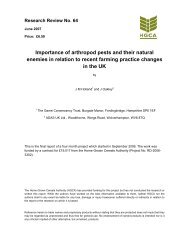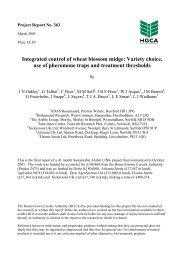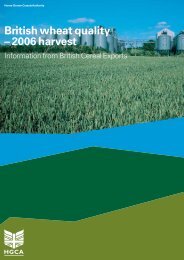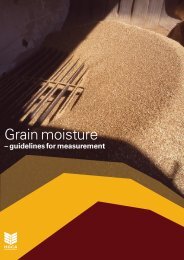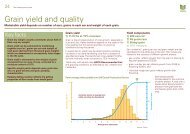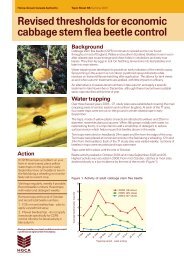BIOETHANOL GREENHOUSE GAS CALCULATOR - HGCA
BIOETHANOL GREENHOUSE GAS CALCULATOR - HGCA
BIOETHANOL GREENHOUSE GAS CALCULATOR - HGCA
You also want an ePaper? Increase the reach of your titles
YUMPU automatically turns print PDFs into web optimized ePapers that Google loves.
20As in the LCVP study, imported soya bean meal from the USA is chosen as theanimal feed product that is substituted by DDGS in calculations of animal feedcredits. Future versions of the Calculator would allow for a choice of different animalfeed products substituted, but currently only limited data is available on lifecycleGHG emissions from production of other animal feed products that may be displacedby DDGS. Each kilogram of DDGS is considered to substitute for 0.78 kg of soyabean meal, on the basis of relative protein content (Concawe, 2003). Production in theUSA and transport to the UK of each kilogram of soya bean meal result in emissionsof 0.46 kg CO 2 eq.For DDGS used as fuel in co-firing for electricity production, a credit of 945 kgCO 2 eq per tonne of DDGS is applied. This is based on the assumptions that:• DDGS (10% moisture) has a lower heating value of 18.2 GJ/t, the same aswheat grain on a dry basis.• DDGS is converted to electricity at the UK average rate of 0.325 gigajoule ofelectricity output per gigajoule of primary energy input.• The electricity generated from DDGS substitutes for other electricitygeneration with GHG emissions equal to the UK average of 160 kgCO 2 eq/GJe (Table 4).It may be argued that electricity generated by the cofiring of DDGS with coaldisplaces marginal coal-based electricity generation, and that the calculations of GHGemission credits should be based on this coal-derived electricity rather than the UKgrid average. This will need to be considered in future versions of the Calculator.5.6.2 Surplus electricityAny surplus electricity produced by an ethanol plant (that is, any electricity that isgenerated but not used by the plant) is assumed to displace generation of an equalamount of grid-supplied electricity with GHG emissions equal to the UK electricitygeneration average of 160 kg CO 2 eq/GJe, and this value is used to calculate creditsfor those ethanol production chains which include generation of surplus electricity.5.6.3 Set-aside, carbon dioxide and strawIn the Calculator, all wheat for ethanol production is assumed to be grown onrotational set-aside, and a credit of 922 MJ/ha (equivalent to 25.8 l/ha of diesel fuel) isapplied for avoidance of maintenance of set-aside land.As discussed in section 5.3 above, no credits are assigned for straw not used as fuel inthe ethanol plant. Similarly, no credits are assigned for any carbon dioxide by-productthat may be captured from the wheat-to-ethanol fermentation process. Most of thecarbon dioxide that is produced and sold industrially originates as a by-product ofother industrial operations, and if this CO 2 was not captured, it would be vented toatmosphere. Thus, CO 2 capture from bioethanol production would not result in a netdisplacement of CO 2 emissions. If carbon dioxide is captured and stored indefinitely,then a CO 2 credit would be appropriate. Future versions of the Calculator maytherefore need to include such a credit.



